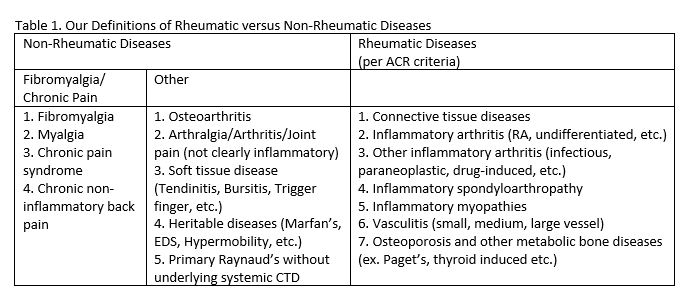Session Information
Date: Sunday, November 7, 2021
Title: Measures & Measurement of Healthcare Quality Poster (0623–0659)
Session Type: Poster Session B
Session Time: 8:30AM-10:30AM
Background/Purpose: Healthcare access in our Rheumatology Department is challenging. Fibromyalgia is perceived to occupy a large portion of clinic visits, leading to increased wait times for our rheumatic patients. We seek to understand our patient population and compare rheumatologist perception of wait times, types of disease referrals, and diagnoses to actual data.
Methods: Data on new clinic referrals between 1/1/19 – 6/30/19 were obtained via manual chart review in EHR. Table 1 lists definitions of rheumatic vs non-rheumatic diagnoses used to categorize disease. Rheumatologist perception of access to care and visit types seen was assessed via an 11-question survey (Table 2). Question 1 analyzed median wait time from date referred to seen while question 11 analyzed median visits per year of fibromyalgia patients. Their statistical analysis was calculated via Sign-test. Questions 2-10 analyzed types of conditions referred and diagnosed, referral accuracy, and fibromyalgia patients seen for a single visit. Statistical analysis was calculated using the mean via 1-proportion Z-test. A sub-analysis comparing actual diagnosis of self- vs physician-referrals was measured via Chi-Square test.
Results: There were 2,327 patient charts reviewed in EPIC. 94% of rheumatologists participated in the survey. Table 2 summarizes the results for questions 1-11. Median wait time from referral to clinic visit was 42 days. Discordance existed between physician perception and actual data for the percentage of patients referred and diagnosed with rheumatic disease, fibromyalgia and other disease. Physicians hypothesized that 47.5% of referrals are for rheumatic disease, 32.8% for fibromyalgia, and 24.4% for other disease compared to actual data of 62%, 7.8%, and 30.4%, respectively. They also hypothesized that 40% of patients are diagnosed with rheumatic disease, 38.4% with fibromyalgia, and 25.6% with other disease compared to 45.2%, 12.2%, and 45.9% of the actual diagnoses, respectively. Concordance existed for patients referred for non-rheumatic disease (13.5%), ultimately diagnosed with rheumatic disease (14.4%). Discordance existed between patients referred for rheumatic disease (51%), ultimately diagnosed with non-rheumatic disease (36%). 70% of fibromyalgia patients were seen for a single visit, concordant with physician perception. Fibromyalgia patients were seen less frequently per year than hypothesized (1 time vs 2). No association existed between type of referral (self vs physician) and ultimate diagnosis.
Conclusion: Timely rheumatologic care is essential to achieve the best outcomes and prevent disability. In order to achieve optimal patient access, we must first understand objective data on rheumatology referrals and diagnoses. Rheumatologist perception of high-volume fibromyalgia/chronic pain referrals was not reflective of the reality of visits in our clinic. Significantly less fibromyalgia/chronic pain was referred and ultimately diagnosed than hypothesized. Significantly more non-inflammatory disease, particularly osteoarthritis, was diagnosed than expected. This study helped us better understand the population we serve so we can more effectively redesign care to improve access and quality.
*Q1, Q11, physician perception hypothesized is the median of rheumatology physician perception estimates from the survey. Comparison analysis to observed data completed via Sign-Test.
To cite this abstract in AMA style:
Koons K, Cote J, Shrestha S, Band M, Pugliese D, Newman E. Understanding the Rheumatologic Population We Serve Through Objective Analysis of Referrals and Diagnoses: Does Perception Match Actual Data? [abstract]. Arthritis Rheumatol. 2021; 73 (suppl 9). https://acrabstracts.org/abstract/understanding-the-rheumatologic-population-we-serve-through-objective-analysis-of-referrals-and-diagnoses-does-perception-match-actual-data/. Accessed .« Back to ACR Convergence 2021
ACR Meeting Abstracts - https://acrabstracts.org/abstract/understanding-the-rheumatologic-population-we-serve-through-objective-analysis-of-referrals-and-diagnoses-does-perception-match-actual-data/


